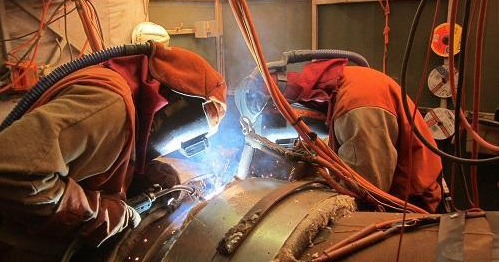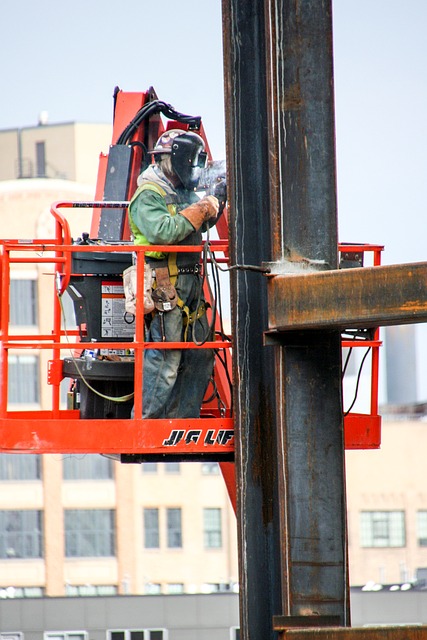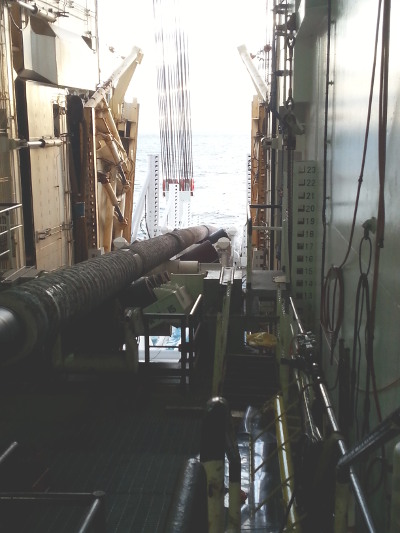WelderDestiny › Certified Welder › Welding Codes
Welding Codes
Welding codes establish the basis for performing Welder qualification tests, or coding tests. There are a large number of different codes. The reasons for the large number of codes are:
- Codes tend to be industry and application specific. (e.g. Piping; Pipeline; Structural; Aerospace; Petrochemical etc.)
- Codes tend to be jurisdiction specific. Historically different countries and / or regions in the world have developed their own codes. While theoretically it would be possible for everyone to just go to a single set of codes, there are political and strategic reasons that states and organizations may not want to do this.
The WelderDestiny Compass: Weekly e-zine Subscription
You can take a look at "The WelderDestiny Compass" back-issues by clicking here.
It
would not add a whole lot of value to try and list all possible welding codes
here. Rather we will look at the most typical internationally used codes. In
addition, it is not the intention to give detailed descriptions or analyses of
each code. Rather we will just make general comments of their applicability so
that you can understand which codes you may want to get hold of, based on the
niche welding area you may be interested in. Please do not see the welding
codes listed here as an exhaustive list. There are hundreds of different codes
that are more niche than makes sense to list here.
 Cross Country Pipeline - Typically Welded to API 1104
Cross Country Pipeline - Typically Welded to API 1104Referenced VS Referencing Codes
It
is important to understand that some codes are referencing codes, and some,
referenced codes. What does this mean?
- Referencing code: This code is the base document that references the use of other codes. Typically referencing codes will be the design codes for the specific equipment that you will be manufacturing or maintaining. (e.g. ASME VIII for pressure vessels, or ASME B31.3 for process plant piping.) The referencing code may override the requirements stated in the referenced code, or add to those requirements.
- Referenced code: This code is one that must be used, because the referencing code told you to do so. Most welding codes are referenced codes. Some requirements of referenced codes may be overridden by the referencing code, or have additional requirements specified by the referencing code.
The importance of knowing this difference is that sometimes you may be allowed to do something that appears to not be allowable in the welding code, or alternately you may be required to meet requirements that is more stringent than that specified in the welding code.
It
is also instructive to note that some design codes or standards will give
guidelines for what the welding code needs to cover, without actually
nominating a specific welding code. It is then up to the end user, and possibly
the validation body associated with the particular structure, to specify the
welding code to follow. Under this scenario there will usually be additional
requirements that will need to be met. For example, ISO 19902 (Off-shore
structures) takes this approach.
Client Standards
Most
large corporations have their own in-house standards. Mostly these standards
clarify which industry codes must be followed, but they may also specify
additional requirements over and above those specified in the welding code.
We
will not go into these client standards here, as it would be totally
impractical given the large number of client organizations out there. It is
however important for you as a Welder to understand that sometimes you will be
required to do some rather unusual things to meet some of these client
standards, or the coupons will be subjected to more rigorous testing than
required by the welding code.
American Based Industry Welding Codes
Some
of the most widely used international codes are American codes. Mostly
they are published by the American Welding Society (AWS) and the American
Society of Mechanical Engineers. (ASME) The most widely used codes are:
- ASME IX: This is the welding code referenced by most of the American codes that deal with the design and manufacture of pressurized equipment. For example, it is referenced by ASME VIII (Pressure vessels), ASME B31.3 (Process plant piping), ASME B31.8 (Gas transmission piping), API 6D (Valves), API 6A (Well-head equipment), API 650 (Tanks for oil storage), ASME B31.4 (Pipelines for liquids and slurries), ISO 10423 (Wellhead equipment), ISO 13628-4 (Subsea wellhead equipment). Besides the design codes, ASME IX is referenced in many material standards and specifications (Especially ASTM specifications) where components are manufactured or repaired by welding.
- API 1104: This code deals with the welding of carbon steel and low-alloy steel pipelines. It is referenced by pipeline codes such as ASME B31.4 (Pipelines for liquids and slurries), ASME B31.8 (Gas transmission piping)
- AWS D1.1: This code is a fabrication and welding code, and deals with steel structures. It is referenced by many codes, standards and recommended practices dealing with large steel structures, like API RP 2A (Offshore platforms), EEMUA 158 (Offshore structures in the North Sea)
- AWS D1.X: Here the X refers to a number of different structural codes that deal with structures made from materials other than carbon steel. (e.g. Stainless steel; Aluminum; reinforcing steel etc.)
- AWS B2.1: This is a specification that is not necessarily limited to a specific industry or product type. It can be referenced by any other code as required. An example of a referencing code is: AWS D14.4: This code deals with the welds in machinery and equipment.
- AWS D1.5: This is the bridge welding and fabrication code.
- AWS D14.1: This is the specification for welding of cranes and material handling equipment.
- AWS D17.1: This is the specification for welding in aerospace applications.
- AWS D3.6: This is the underwater welding code.
 Structural Steel Typically Welded to AWS D1.1 Structural Steel Typically Welded to AWS D1.1 |
 Subsea Pipeline Typically Welded to DNV-OS-F101 Subsea Pipeline Typically Welded to DNV-OS-F101 |
As mentioned earlier, this is not an exhaustive list, but it is a good starting point. Also keep in mind that even though there are many different welding codes, many of their requirements overlap, so it is possible to perform a single Welder qualification coupon that could qualify you to weld to a number of different codes. The inspection and testing must just meet the requirements of the different codes.
European Based Codes
When
looking at the European based codes, we are considering the welding codes that
have grown out of traditionally European national codes. A great deal of these
codes have morphed into ISO codes and standards. Strictly speaking the ISO
codes are "international" rather than just European, and are being
used more widely even within the USA, however we will list them here under the
European heading, because that is largely where their historical base lies.
- ISO 9606: This is actually a series of standards that cover the qualification of Welders for a range of different materials. For most materials, ISO 9606 has superseded EN 287, although for the steels, EN 287-1 is still widely referenced. I suspect that eventually ISO 9606 will totally supersede EN 287.
- EN 287-1: This is a code dealing with welder qualifications for steels, for a wide range of different European and ISO codes. It is not really industry or product form specific. Examples of referencing codes are: EEMUA 158 (Offshore structures in the North Sea), EN 13445-4 (Fabrication of unfired pressure vessels), EN 14015 (Steel Tanks), Norsok M-101 (Fabrication of steel structures), DNV-OS-F101 (Subsea pipelines), BS 5500 (Pressure Vessels)
- BS 4515-1: This deals with carbon steel pipelines within British jurisdictions.
- ISO 14732: This code deals with the qualification of Welder operators for mechanized and automatic welding.
- ISO 15616: A number of different standards dealing with the qualification of Welders for hyperbaric (underwater) welding.
Miscellaneous Industry Codes
There are some industry codes that are widely used internationally, that are not necessarily based on country or regional standards. These could be based on a standard issued by a validation body that has just become the industry norm over time. A prominent example of such a code is:
- DNV-OS-F101: This is the most widely used code for design, manufacture and installation of subsea pipelines. I have included this here for completeness sake, but often Welders welding to this code will perform coupons in accordance with EN 287, with additional requirements as amended by the DNV standard.
Revalidation of Welder Qualifications
Seeing as welding is a skill, it is possible for a Welder to lose the particular skills tested in a Welder qualification, if the Welder does not perform similar welding for an extended period of time. Welders therefore need to have their Welder Performance Qualifications (WPQ) revalidated on a regular basis to indicate that they still have the necessary skills to perform the required welding.
Different
codes have slightly different requirements for the revalidation of the
Welder qualifications, but the most widely used methodology is that if the
Welder has welded with the specific welding process in the preceding 6 months,
then the qualification is revalidated. If the Welder has not welded with a specific
welding process for longer than 6 months, then the qualifications in which that
specific process was used, will lapse. (They "expire") Revalidation
is then accomplished by the Welder re-doing at least one test coupon using the
lapsed welding process.
As mentioned, there are subtle differences between codes in this regard, but the approach mentioned above is the most widely used revalidation process.
WelderDestiny › Certified Welder › Welding Codes
The WelderDestiny Compass: Weekly e-zine Subscription
You can take a look at "The WelderDestiny Compass" back-issues by clicking here.